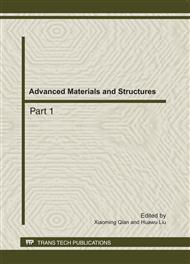p.333
p.339
p.343
p.347
p.351
p.355
p.359
p.363
p.368
Finite Element Analysis of Centrally-Debonded Composite Sandwich Beam under Four Point Bending
Abstract:
Sandwich structure, with high specific strength, high specific stiffness facesheet and light-weighted core material bonded together, is one of commonly used composite structures. During the manufacturing process, it is possible to have debonding between facesheet and core. This facesheet/core debonding affects the mechanical property and strength of sandwich structure. In this study, sandwich beams are made of graphite/epoxy laminate as facesheet and MWNTs/epoxy nanocomposites as core material. The composite sandwich beam, with a central facesheet/core debond and under four point bending, was analyzed by the finite element method. The length of the debonding layer, the fiber orientation of the facesheet laminate and MWNTs content in core were varied to assess their effects on the bending behavior and the strengths of the centrally-debonded sandwich beams.
Info:
Periodical:
Pages:
351-354
Citation:
Online since:
September 2011
Authors:
Price:
Сopyright:
© 2011 Trans Tech Publications Ltd. All Rights Reserved
Share:
Citation:


